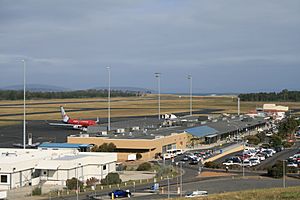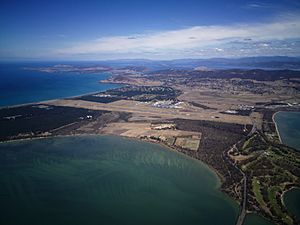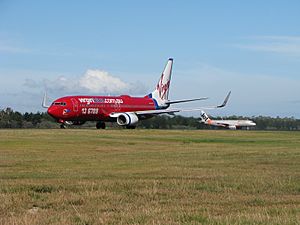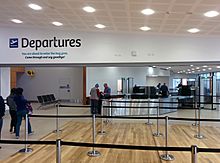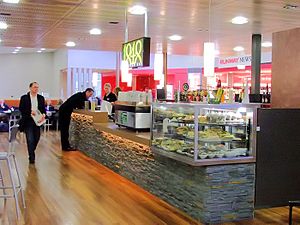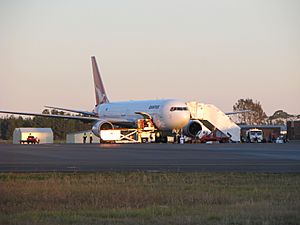Hobart Airport facts for kids
Quick facts for kids
Hobart Airport
|
|||||||||||
|---|---|---|---|---|---|---|---|---|---|---|---|
 |
|||||||||||
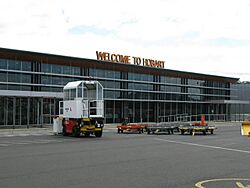
Hobart Airport terminal and aircraft apron
|
|||||||||||
| Summary | |||||||||||
| Airport type | Public | ||||||||||
| Owner | Queensland Investment Corporation (35%) Schiphol Group (35%) CareSuper (30%) |
||||||||||
| Operator | Hobart Airport Pty Ltd | ||||||||||
| Serves | Hobart | ||||||||||
| Location | Cambridge, Tasmania, Australia | ||||||||||
| Opened | 1956 | ||||||||||
| Hub for | QantasLink | ||||||||||
| Elevation AMSL | 13 ft / 4 m | ||||||||||
| Coordinates | 42°50′12″S 147°30′36″E / 42.83667°S 147.51000°E | ||||||||||
| Runway | |||||||||||
|
|||||||||||
| Statistics (2016–2017) | |||||||||||
|
|||||||||||
|
Source: AIP
passengers from the Department of Infrastructure & Transport Operations from Airservices Australia |
|||||||||||
Hobart Airport is a busy airport in Cambridge, Tasmania. It is about 17 kilometers north-east of Hobart, the capital city of Tasmania. This airport is the main gateway for air travel to and from Tasmania.
The airport is owned by the Australian government. It is managed by a group called the Tasmanian Gateway Consortium. They have a long-term lease to operate the airport.
Hobart Airport has one building that handles both international and domestic flights. Big airlines like Qantas, Jetstar, and Virgin Australia fly here. They mostly offer flights to major Australian cities like Melbourne, Sydney, and Brisbane. You can also catch international flights to Auckland, New Zealand, a few times a week with Air New Zealand.
Because Hobart is so far south, it's also a special base for flights to Antarctica. A company called Skytraders flies an Airbus A319 plane there for the Australian Antarctic Division.
Hobart Airport first opened in 1956. It became a private company in 1988. The airport is built on a narrow piece of land. This means planes always take off and land over water. The area around the airport is mostly empty. This allows planes to fly at any time, day or night, without bothering many people.
In the 2018–19 financial year, over 2.6 million passengers used the airport. This made it the ninth busiest airport in Australia at that time.
Contents
Airport History
Before Hobart Airport existed, there was a smaller airport nearby called Cambridge Airport. It was only good for small planes. As more people started flying, a bigger airport was needed.
In 1948, the Australian Prime Minister announced plans for a new airport. It would cost a lot of money back then. Because Australia is very interested in Antarctica, it was thought that the southernmost airport would be perfect for large planes going to that region.
Hobart Airport officially opened in 1956. It was first called Llanherne Airport, but that name is not used anymore. In its first year, over 120,000 passengers used the airport. It also handled a lot of cargo.
Over the years, the airport grew. In 1964, the government made the runway longer for jet aircraft. It was made even longer in 1985 for very big planes like the Boeing 747. The current domestic terminal opened in 1976, and the international terminal opened in 1986.
Becoming a Private Airport
In 1998, Hobart Airport became a private business. A group of companies bought a 99-year lease to run it. This meant the government no longer owned or operated it directly.
In 2004, the domestic terminal got a big makeover. It was made more modern, and shops were moved inside the security area. The car park was also changed. In 2005, more people than ever used the airport. This led to plans for even more upgrades to make more space for passengers.
In 2007, the Tasmanian Government sold its share of the airport. It was bought by the Tasmanian Gateway Consortium. This group included Macquarie Capital and Tasmania's public sector superannuation fund. In 2019, Macquarie Capital sold its share to other companies.
Recently, in February 2024, work began to make the terminal twice as big. Also, in July 2024, upgrades started on the runway. These upgrades were finished in August 2025. They allow the airport to handle even bigger planes like the Airbus A350 and Boeing 787.
Airport Terminals
Hobart Airport has two main areas for passengers. In 2007, these two areas were connected. This was done to follow new rules about checking all luggage with X-rays. The airport even won an award for its new terminal design.
The airport currently has one large area for all planes to park. This includes international, domestic, and smaller private planes. There are plans to build a separate parking area for smaller private planes in the future. The terminal building is also planned to get much bigger, almost doubling in size.
Domestic Terminal
The domestic terminal opened in 1976. It has been made bigger several times since then. All airlines use the same check-in and departure areas. There is a special lounge for Qantas passengers. The arrivals area has two baggage carousels where you pick up your bags. One of these can be used for international arrivals when needed. The domestic area has space for many medium-sized planes.
International Terminal
The international terminal opened in 1983. It was built for flights between Australia and New Zealand. In 1985, this terminal and the runway were upgraded for larger planes.
For a long time, there were no regular international flights. But in April 2021, Air New Zealand started flying directly to Auckland again. These flights happen a few times a week. The international terminal is also used by Skytraders for flights to Antarctica. It can handle very large planes like the Boeing 747-400.
Freight Services
Hobart Airport also handles a lot of cargo. There are two main areas for domestic freight. Companies like Qantas and Toll Air use these facilities. They have buildings and space for loading and unloading goods. Some planes are just for cargo, while others carry cargo in their passenger planes.
General Aviation
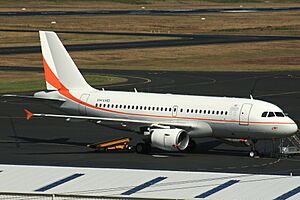
Most small private planes use the nearby Cambridge Aerodrome. However, Hobart Airport has plans to expand its facilities for general aviation. This would include a new runway and parking area for smaller planes. This would happen if Cambridge Aerodrome ever stopped being an airport.
The Runway
Hobart Airport has one main runway, called 12/30. It is 2,727 meters long and 45 meters wide. The runway was made longer in 2017. It is built with a strong asphalt surface. This makes it suitable for almost all large aircraft, including Boeing 777 and Boeing 747 planes. The current runway is long enough for planes like the Boeing 787-9 to fly to places like China and Japan without any problems.
The airport has plans to build a parallel taxiway. This is like a separate road next to the runway. Right now, planes sometimes have to use the main runway to taxi to their parking spots. This means other planes cannot use the runway at the same time. A parallel taxiway would allow planes to land and then move off the runway quickly. This would make the airport more efficient and safer.
There are also plans for a second, shorter runway for smaller planes. This would help manage different types of aircraft better. However, the airport's main runway is not used to its full capacity yet, so a second runway is not likely to be built very soon.
Other Airport Facilities
Airport Hotel
In 2008, a hotel called the Quality Hotel Hobart Airport opened. It has 78 rooms, a restaurant, and meeting spaces. It's a convenient place for travelers to stay right at the airport.
Cold Storage and Warehousing
Since December 2018, Link Logistics International has operated a cold storage facility at the airport. This is a huge refrigerated warehouse. It stores many different products that need to be kept cold. This includes seafood, fruits, vegetables, craft beer, and wine. It helps businesses store their goods before they are flown out or after they arrive.
Airlines and Destinations
| Airlines | Destinations |
|---|---|
| Air New Zealand | Seasonal: Auckland |
| Jetstar | Adelaide, Brisbane, Gold Coast, Melbourne, Sydney |
| Link Airways | Canberra |
| Qantas | Melbourne, Sydney Seasonal: Perth |
| QantasLink | Brisbane, Melbourne, Perth (resumes 26 September 2025), Sydney Seasonal: Adelaide, Canberra |
| Skytraders | Seasonal charter: Wilkins Runway |
| Virgin Australia | Brisbane, Melbourne, Perth, Sydney Seasonal: Adelaide |
| Virgin Australia Regional Airlines | Perth |
Qantas used to offer special "flightseeing" trips over Antarctica from Hobart. These flights used a Boeing 787 Dreamliner. They gave passengers a guided tour of Antarctica from the air. The whole trip lasted about thirteen hours.
Before April 2023, Sharp Airlines flew from Hobart to other Tasmanian towns. These included Launceston, Burnie, King Island, and Flinders Island.
Cargo Flights
| Airlines | Destinations |
|---|---|
| Cathay Cargo | Seasonal charter: Hong Kong, Melbourne, Sydney |
| Qantas Freight | Launceston, Melbourne |
| Pionair Australia | Seasonal charter: Sydney |
Airport Traffic and Statistics
| Rank | Airport | Passengers | % change |
|---|---|---|---|
| 1 | 1,373,100 | ||
| 2 | 804,800 | ||
| 3 | 307,000 |
| Year | Domestic | International | Total | Change |
|---|---|---|---|---|
| 1998 | 855,934 | 2,690 | 858,624 | |
| 1999 | 877,992 | - | 877,992 | |
| 2000 | 927,957 | - | 927,957 | |
| 2001 | 996,179 | - | 996,179 | |
| 2002 | 947,682 | - | 947,682 | |
| 2003 | 1,101,555 | - | 1,101,555 | |
| 2004 | 1,380,849 | - | 1,380,849 | |
| 2005 | 1,600,185 | - | 1,600,185 | |
| 2006 | 1,617,810 | - | 1,617,810 | |
| 2007 | 1,663,596 | - | 1,663,596 | |
| 2008 | 1,830,870 | - | 1,830,870 | |
| 2009 | 1,874,459 | - | 1,874,459 | |
| 2010 | 1,882,092 | - | 1,882,092 | |
| 2011 | 1,844,681 | - | 1,844,681 | |
| 2012 | 1,919,026 | - | 1,919,026 | |
| 2013 | 2,091,706 | - | 2,091,706 | |
| 2014 | 2,127,981 | - | 2,127,981 | |
| 2015 | 2,238,432 | - | 2,238,432 | |
| 2016 | 2,378,137 | - | 2,378,137 | |
| 2017 | 2,510,343 | - | 2,510,343 | |
| 2018 | 2,676,628 | - | 2,676,628 | |
| 2019 | 2,781,739 | - | 2,781,739 | |
| 2020 | 879,663 | - | 879,663 | |
| 2021 | 1,261,289 | 4,480 | 1,265,769 | |
| 2022 | 2,289,011 | 14,527 | 2,303,538 | |
| 2023 | 2,579,514 | 31,915 | 2,611,429 | |
| 2024 | 2,729,286 | 20,292 | 2,749,578 |
Getting To and From the Airport
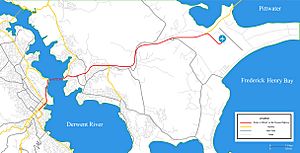
Hobart Airport has car parks for short, medium, and long stays. You can also find taxis and limousine services easily. Many car rental companies also have offices at the airport.
For public transport, a SkyBus service started in June 2018. This bus travels between the airport and the Hobart central business district. It leaves every 30 minutes, making it easy to get to and from the city.
See also
 In Spanish: Aeropuerto Internacional de Hobart para niños
In Spanish: Aeropuerto Internacional de Hobart para niños


